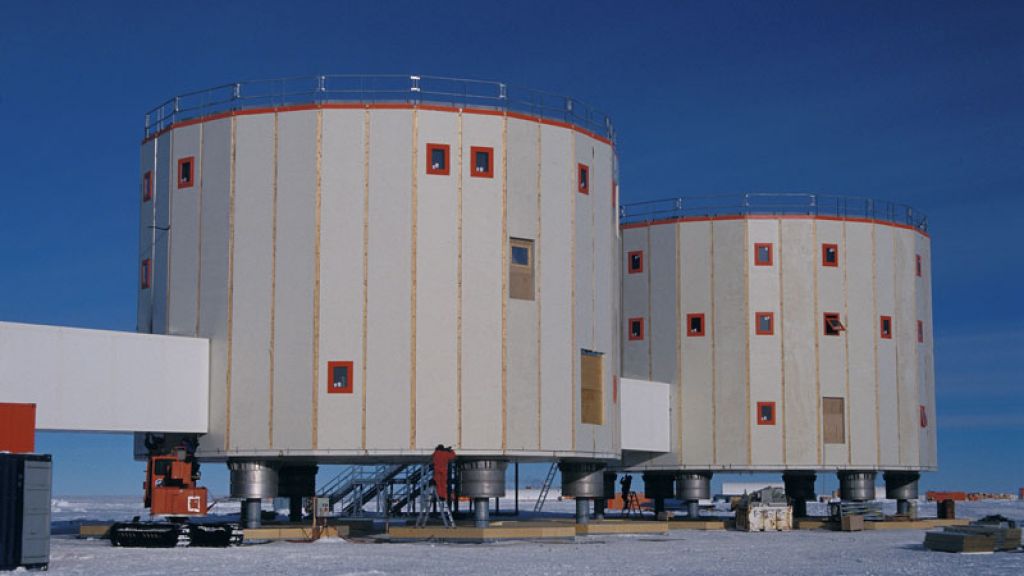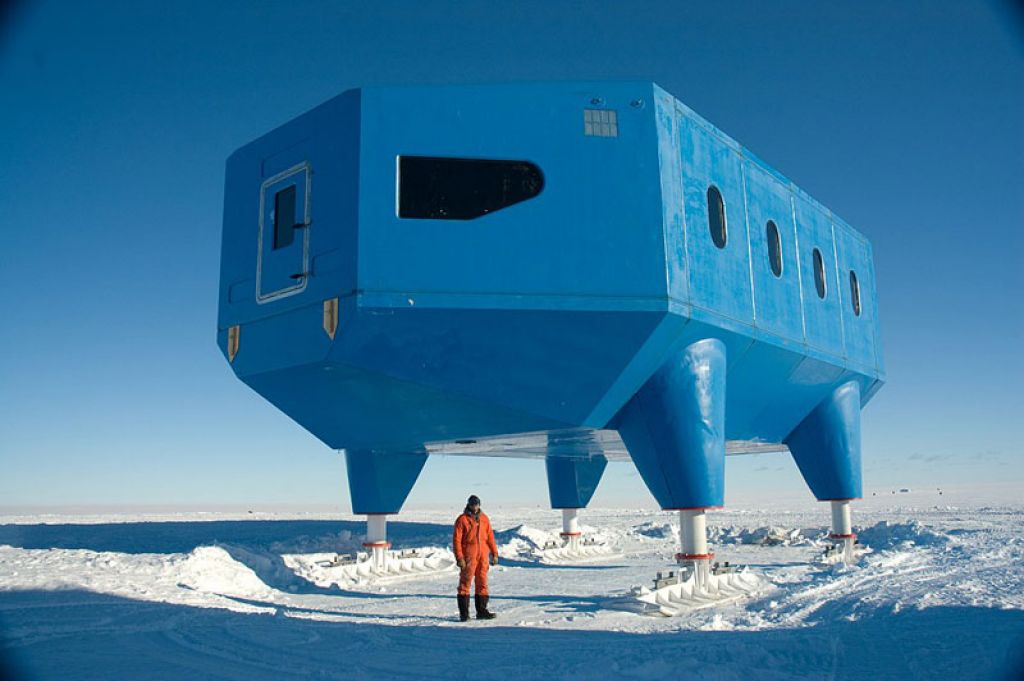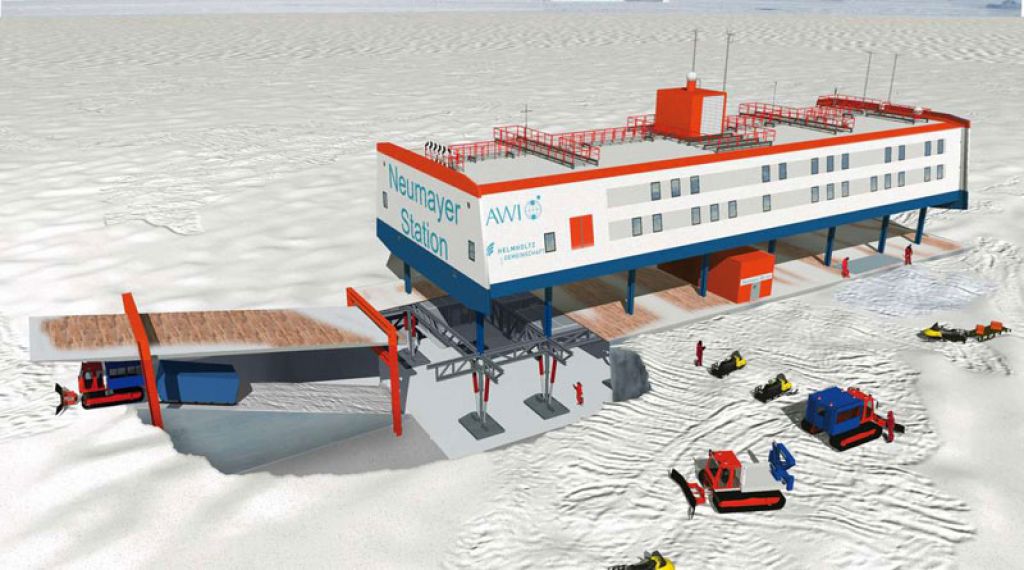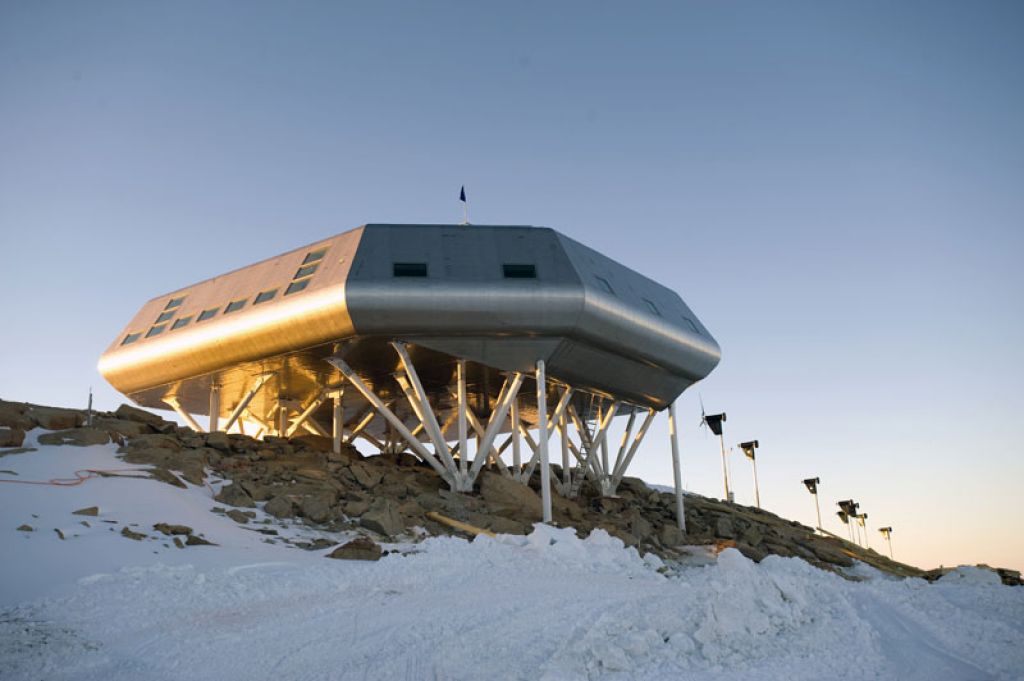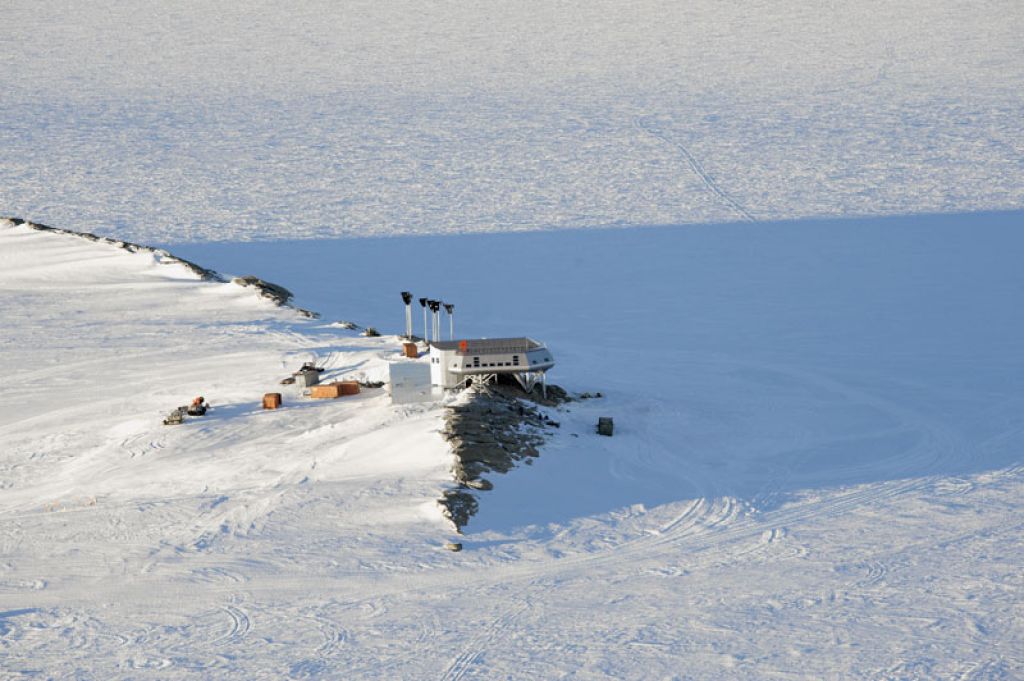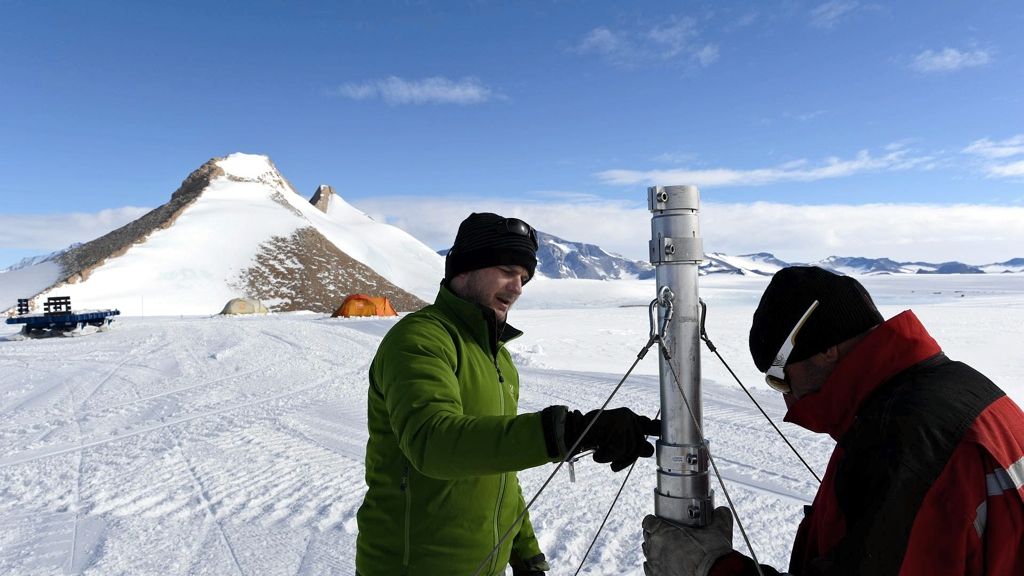Grand designs: new Antarctic research stations for the IPY
Concordia Station
© A. Manouvrier / IPEV
One of the lasting legacies of the International Polar Year (IPY) 2007-08 will be a series of high-tech scientific research stations recently completed or in the process of being constructed in Antarctica. Never since the International Geophysical Year of 1957-58 has the frozen continent seen such intense infrastructure building activity, or such a rapid increase in research capacity.
Futuristic in their design and all specifically adapted to the Antarctic environment, the new stations draw on the latest technological and design innovations to maximise functionality and minimise their environmental footprint in accordance with the requirements set by the Protocol for Environmental Protection to the Antarctic Treaty. In this perspective, they share similarities such as waste treatment plants, but also stilts (or hydraulic legs) to prevent them from being swallowed up by snow accumulation, thus facilitating their dismantlement after decommissioning.
Beyond these resemblances, however, the new stations also vary significantly in scale, scientific function, geographic location, and energy reliance.
On the occasion of the 31st Antarctic Treaty Consultative meeting held in Kiev, Ukraine, from the 2nd to the 13th of June 2008, SciencePoles looks at each station or project individually, and explains what makes them unique.
Dome A Station (China)
At 4,093 metres, Dome Argus (Dome A) is the culminating point of the East Antarctic ice sheet and perhaps also the coldest place on Earth with a measured average annual temperature of -58.4°C. Located some 1,220 kilometers inland, close to the center of the continent, it is also one of the remotest and least visited locations in Antarctica. Consequently, building a research station there represents a huge technological, logistical, and human challenge.
Following a series of inland surveys undertaken since 1996, and of two reconnaissance expeditions from the coastal Zhongshan station to Dome A during the 2004-05 and 2007-08 Austral summer seasons, China has opted to rise to this challenge. It will start construction of its Dome A station in the 2008-09 season, with a planned completion for February 2010. Jointly coordinated by the Chinese Arctic and Antarctic Administration (CAA) and Polar Research Institute of China (PRIC), and designated as a project of the highest priority by the Chinese State Oceanic Administration, Dome A is initially intended as a summer only station for 15 to 20 scientists and personnel. After operational period of some ten years, it will be upgraded to an all year station housing some 25 people.
The total surface area of Dome A station will be 623m2. It will comprise of a series of buildings, some of which will be assembled on site, and others which will be made from specially adapted containers.
With a surface area of 283m2, raised on stilts to limit snow-drift accumulation and the sinking of the station into the ice sheet, the main building will house living accommodations, a multifunction room for eating and other activities, laboratory space, and a medical unit. A series of separate logistics buildings, totaling 340 m2, will house generator units, fuel tanks, solar energy facilities, storage units, and most importantly, and autonomous emergency shelter situated some distance from the station and able to house personnel in case of fire in the main building.
In addition to the principle station buildings described above, Dome A will also include a 1,000m2 simple storage area and operational yard, and a further 200m2 to house solar energy photovoltaic facilities.
Dependant on aviation kerosene for the first few years of operation, it is hoped that the station can transition to solar energy as the main source of electric power within 2-4 years. In line with its objective to reduce its environmental footprint to a minimum, the station will employ advanced technology for sewage and all liquid waste treatment. All solid waste will be transported back to the coastal Zhongshan station and shipped out of Antarctica.
Whilst the creation of an air-bridge between Zhongshan and Dome A is currently under investigation, in the nearer future, all transport and logistical support will continue to be provided by tracked vehicle overland traverses that take some 18 days to cover the 1,280 kilometers between the two stations.
As a result of its very high altitude and oxygen levels that are closer to those found at more than 5,000 meters nearer the equator (the Earth's centrifugenal force thinning the atmosphere at the Poles), engineers are also looking at the possibility of setting up an oxygen generation station to pump and supply extra oxygen inside the station in order to make living conditions more comfortable for its occupants.
Behind all these logistical efforts and investments, rests the extremely rich research potential of Dome A station, reflecting many of the major science themes of the IPY, and providing the potential for far-reaching scientific discoveries in both the Earth and space sciences. In particular, but not exclusively, the research program will include:
- Glaciology and ice core drilling, with the hope of retrieving the Earth's oldest ice core going back and providing scientists with 1.2 to 1.5 million years of climate history.
- Geology and geomorphology, studying the sub-glacial Gamburtsev mountain range beneath Dome A to answer many remaining questions about ice sheet formation and the creation of East Antarctica.
- Aircraft remote sensing and the setting up of an unmanned observational network system.
- The formation and global effects of geomagnetic chains; atmospheric vertical structure and ozone observations.
- Medical research and the effects of extreme cold, strong ultraviolet, geomagnetism and low oxygen on human physiology.
- Astronomical observations, with Dome A's high altitude, low wind, extreme atmospheric transparency, long polar nights, and absence of light pollution providing what could be the best platform on Earth for astronomy and astrophysics.
Neumayer III (Germany)
First built in 1981 on the floating Ekström ice shelf in East Antarctica, Neumayer I station was named after the Georg Von Neumayer, an important patron of Germany's research activities in Antarctica. Built as a research observatory for geophysical, meteorological and air chemistry measurements, as well as a logistics base for summer expeditions, it had to be replaced by Neumayer II in 1992 due to snow accumulation and the flow of the ice shelf towards the sea.
Now itself buried 12 meters under the snow surface and under increasing structural pressure, Neumayer II must be replaced by a new station, Neumayer III, to be built by the Alfred Wegener Institute (AWI) at a reported cost of 26 million Euros. Due for completion in the spring of 2009 (coinciding with the end of the IPY), Neumayer III was shipped to Antarctica in January 2008 as an assembly kit comprising of the outer structure and shell of the station, and of the interlocking containers that sit inside and make up its interior habitable structure.
Unlike it's predecessors, but echoing the new generation of stations currently under construction in Antarctica, Neumayer III will consist of a superstructure raised on 16 hydraulic legs (resting on as many foundation slabs) that can be jacked up progressively over the years to elevate the building and counter snow accumulation. In addition, dug into the snow beneath the entire building, there will be a large garage, technical and modulable storage space linked to the superstructure by an interior stairwell shaft, and accessible to vehicles by a wide ramp leading to the exterior.
Reliant on diesel generators for its energy supply, Neumayer III's electricity demand will nevertheless be supplemented by a wind power plant. Meeting the requirements of the Protocol for Environmental Protection to the Antarctic Treaty, the station will also comprise a water and waste treatment plant.
With its imposing size and weight (2,300 tons), the two storey superstructure will integrate research, operational and accommodation facilities, and share structural similarities with the US South Pole Station: its exterior casing also profiled something like an airliner wing so as to increase wind flow and reduce snow accumulation. This, in conjunction with the hydraulic legs on which it is raised, should extend the life of the station to between 25 and 30 years.
Once the station is completed, logistics and transport at Neumayer III will continue to be provided by ship for heavy goods and re-supply, and to a lesser extent by the Alfred Wegener Institute's (AWI) ski equipped aircrafts for transport of personnel.
From the perspective of science, Neumayer III will permit the deployment of new research projects under proposal, as well as housing ongoing meteorological, geophysical and atmospheric observatories, monitoring everything from the Earth's radiation budget and its impact on climate, to the Earth's magnetic field, to the atmospheric concentration of trace gases such as ozone. The station will also continue to facilitate the Perennial Acoustic Observatory in the Antarctic Ocean (PALAOA), which continuously records the underwater soundscape in the vicinity of the Ekström ice shelf's edge.
Amundsen-Scott South Pole Station (US)
Strategically located at the South Pole and the jewel of the US Antarctic Program, the US Amundsen-Scott South Pole station was first established by the US Navy in 1956. It has since been through two incarnations and structures, most recently the famous geodesic dome erected in 1975 and in the process of being decommissioned and shipped out of Antarctica. Replacing it is a colossal US$ 153 million elevated structure funded by the United States National Science Foundation (NSF) and erected thanks to a massive logistical and engineering effort over the past decade.
Inaugurated in January 2008 (halfway through the IPY), the new station extends to 7,600 m2 split over two floors propped up on 36 hydraulic jack columns. Designed by Ferraro Choi & Associated in Hawaii, it is profiled like an airliner wing so as to avoid snow accumulation. Over the years, the massive structure will also be jacked up in a series of 25 cm increments to prevent it from sinking into the ice sheet below. Designed to resist temperatures as low as -73°centigrade, it houses state of the art laboratories, living quarters, workshops, and even a gymnasium. With a capacity to house up to 250 people in the three month summer season, and between 50 and 75 during the winter months, it is the second largest station in Antarctica (after the US's McMurdo station on Ross Island),
Until now, all goods and materials have had to be airlifted to the South Pole by a wing of ski equipped Hercules C-130 transport planes, meaning that all components, including those used in the building of the new station, had to be designed to fit into the fuselage of the planes. However, in 2007, for the first time in its history, one hundred tones of cargo were transported to the station by a 1,600km "proof-of-concept" overland traverse consisting of tracked vehicles and specially designed sledges. The traverse is set to be repeated in future years so as to reduce logistics costs and free up air support for further deep field research programs.
At the present time, research at the US South Pole station consists majoritively of astronomy and astrophysics, including a huge 10 meter telescope deployed in 2006, and the Ice Cube neutrino sub-particle detector, still in its multiyear deployment phase.
Consisting of nearly 5,000 optical neutrino detectors buried in strings into the Antarctic ice sheet between 1,450 to 2,450 metres under the snow surface, Ice Cube is one of the largest scientific instruments on Earth. It is also by far the most costly research programme currently deployed in Antarctica: A powerful window to the universe and fine example of "blue sky" science, it will enable researchers to learn more about supernovas, the Big Bang, and hopefully other, as yet undiscovered phenomena.
Finally, in addition to astronomy and astrophysics, the new South Pole station also supports important atmospheric, meteorological, geological and glaciological research, including the study of recently discovered sub-glacial lakes lying beneath the ice sheet not far from the South Pole.
Concordia Station (France-Italy)
Completed in 2005 and located at an altitude of 3233 metres, some 1,100 kilometers from the coast, the new Concordia station is built on a site that was first occupied by scientists in the 1970s, and which from 1996 to 2004 was home to the EPICA ice coring project that successfully retrieved a 3,190 metre ice core going back some 800,000 years - the longest in existence, and one of our most precious climate records.
Designed for all year occupancy, the new station consists of two cylindrical buildings and of a technical building, all interconnected by enclosed walkways. The new buildings replace Jamesway tents and other temporary stuctures previously used for summer occupancy only.
Each of the two cylindrical buildings contain three floors and rest on six hydraulic legs that can be raised to adapt to changes in topography and to prevent snow-drift accumulation. One of the buildings is dedicated to quiet activities (mostly bedrooms and laboratories), and the other to noisy activities (kitchen, dining and living rooms, workshops). In winter, the station houses up to 16 people in complete autonomy for nine months. During the short summer season, the population grows to between 32 and 40, with exterior temporary structures still used as extra accommodation.
The third, technical building, is made up of container modules and rests directly on the snow surface, housing the waste treatment plant, power generators, a boiler room, and another workshop. The station is re-supplied in fuel, food and other necessities each summer season by a series of overland traverses, known as 'Le Raid'. These consist of around a dozen tracked vehicles pulling sledges from the French Dumont-d'Urville station located 1,100 km away on the Adèlie Land coastline. The 'Raid' also takes all waste material back to Dumont d'Urville for shipment out of Antarctica.
With the Dome C segment of the EPICA programme now complete, research at Concordia will consist of a mix of climatology, meteorology, astronomy, and geophysics to study continental drift and help calibrate satellite instrumentation. In particular, Dome C's extreme atmospheric clarity, clear skies, extended polar night, and near absence of air turbulence is also deemed ideal for astronomical observation, and the Astrophysics department at the University of Nice is planning to set up an array of thirty-six 1.5 meter telescopes in the coming years.
Princess Elisabeth Station (Belgium)
Belgium was one of the original 12 signatories of the Antarctic Treaty, but has not had a scientific research station in the Antarctic since its King Baudouin station, built for the International Geophysical Year (IGY) in 1958, and decommissioned in 1967.
To end this Belgian absence from Antarctica, and to demonstrate that a zero emission station can be built and operated in one of the most hostile environments on Earth, the International Polar Foundation(publisher of this website) was commissioned by the Belgian government to conceive and carry out the Princess Elisabeth Station project, with the Belgian Federal Science Policy (BELSPO) as a key partner.
Initially intended as a summer only station (with the built-in potential to upgrade to an all year station), Princess Elisabeth will break new ground as the first Antarctic station to function solely on renewable energy through a mixture of wind and solar power. In achieving this feat of design and engineering, it will not only go beyond the requirements set by the Protocol for Environmental Protection to the Antarctic Treaty, but also prove that renewable energy can be applicable even in the harshest environments on Earth.
Rather than being based on an architect's drawing, the station was designed first and foremost with functionality and energy efficiency in mind. The result is an aesthetically elegant hybrid design that consists of one octagonal building raised on stilts anchored into the granite; of two polyvalent warehouse and garage spaces dug into the snow on the flanks of the ridge; and of a series of wind turbines aligned along the ridge on which it stands.
Able to withstand katabatic winds of up to 250km an hour, the main structure includes some 450 m2 of surface area, laid out on a single floor. This will be divided into laboratories, relaxation and eating areas, kitchen and bathrooms, and sleeping accommodations for 12 people. An additional 8 people will be able to sleep in modulable compartments housed inside the 1000 m2 warehouse and garage, which will also contain modulable laboratory facilities as needs arise.
In line with the goal to reduce the station's environmental footprint to a bare minimum, Princess Elisabeth will be equipped with a treatment plant for both grey water and sewage, and will have a recycling capacity for non-potable water applications.
Firmly turned to the future, the station is named after the six year old grand-daughter of the King of Belgium and financed through a mixture of public funding and private sponsorship. Its expected minimal design life is of 25 years, with a building cost in the regions of 11.5 million Euros. Once complete, the Belgian state will fund both the maintenance of the station and the scientific research expeditions.
Shipped to Antarctica as a pre-constructed assembly kit and assembled by the BELARE expedition team over a period of just three months in the 2007-08 austral summer, Princess Elisabeth already stands on top of a granite ridge at Utsteinen in the Dronning Maud Land region of East Antarctica, some 190 kilometers from the coast and 173 kilometers from the old King Baudoin station. The interior and technical outfitting of the station will be carried out in the 2008-09 summer season, in time for its planned inauguration at the end of February 2009 (marking the 50th anniversary of the building of King Baudouin station, and the 110th anniversary of Adrien de Gerlache's Belgica expedition to Antarctica).
Once the station is completed, logistics and transport of personnel will be largely dependant on the Dronning Maud Air Network, with the possibility of more heavy goods sea shipments as needs arise.
Located in the middle a 1,000 kilometer stretch without any existing research infrastructure, Princess Elisabeth is perfectly placed for investigating the characteristic sequence of Antarctic geographical regions, serving as an ideal platform for the study of polynia, coast, ice shelf, ice sheet, marginal mountain areas, dry valleys, and inland plateau, all within a radius of 200 km.
The station will thus provide Belgian scientists with a privileged platform to pursue a research programme focused firmly on global climate change, and also to collaborate with glaciologists, geologists, biologists, and meteorologists internationally. Indeed, already underway is research into the neighboring ice rise that serves to pin down and stabilize the coastal ice sheet, and a biological study of interesting new micro-organisms in the nearby Sør Rondane mountains.
Halley VI (UK)
Located on the floating Brunt Ice Shelf, on the Western coastline of East Antarctica, the first Halley station was built by the UK Royal Society for the International Geophysical Year of 1957-58. It is most famous as the station where the ozone hole was first discovered in 1985.
Halley must be rebuilt upstream on a regular basis due to precipitation (about 120 cm a year) and to the Brunt Ice Shelf's flow towards the sea at an annual rate of about half a kilometre. There have been five separate Halley stations built since 1956. The new station, Halley VI, was shipped to Antarctica by boat as an assembly kit in December 2007. It is now in the process of being reassembled on situ by a team from the British Antarctic Survey (BAS), with a completion date now set for 2010. The official cost of Halley VI is of £34.7 million (£26.2 million for construction, and 8.5 million for the decommissioning and repatriation of Halley V).
Although its predecessor, Halley V, was also raised on jackable steel legs to counter snow accumulation, Halley VI will differ significantly both in design and functionality. In what represents a 'first' for an Antarctic station, its hydraulic legs will all be equipped with skis and the station will consist of eight resembling modules attached together like the carriages of a train. This design will enable it to be dragged and relocated many kilometres inland as the ice shelf flows towards the sea, thus extending its life far beyond what was achieved with the previous fixed designs.
Halley VI will comprise of a larger central module housing living, eating, and relaxation areas, and of seven slightly smaller modules designed to be flexible in their usage and configuration as future needs dictate. These will house laboratories and sleeping accommodations, as well as technical locales, workshops, utilities and storage. As with Halley V, in addition to the main structure, there will be a separate clean air laboratory (CASlab) located away from the main station.
In keeping with the Protocol for Environmental Protection to the Antarctic Treaty, Halley VI will deliver significant innovations in everything from sewage treatment and incinerators, energy saving and power generation, reduction of annual maintenance, and living conditions. Whilst the station will be mostly reliant on diesel generators, solar-thermal and photovoltaic cells systems will supplement power supply during the busy austral summer, when power usage is at its peak. Maintenance will also be reduced thanks to new designs, for example the melt tank that can be refilled mechanically by bulldozers.
With a population of 16 in the winter and up to 70 during the summer, logistics and transport will continue to be provided by ship for heavy goods and re-supply, and to a lesser extent by the British Antarctic Survey's Twin Otter aircrafts for transport of personnel.
Research at Halley VI will continue to focus primarily on atmospheric science and meteorology, in addition to some glaciology and geology. The station will also continue to be one of the key players in the observation of ozone depletion and recovery following the ban of CFC gasses. Lying within the auroral zone, Halley also remains ideally situated for geo-space research and will continue to operate its SHARE radar - part of the Southern Hemisphere Auroral Radar Experiment network.
Beyond IPY
The two publicized station-building projects in the Antarctic following the IPY are lead by Korea and India.
India
The first station likely to be constructed in the few years following IPY is India's second Antarctic station,to be built in the Larsemann Hills in East Antarctica. Slightly smaller than India's existing Maitri Station in the Schirmacher region of East Antarctica, the new station will be designed for all year occupancy with a population of 25 people in the summer, and of around 15 in the austral winter.
To be located on a coastal rock promontory easily accessible by sea, the station is to have an ergonomic design in harmony with the local environment. Constructed as a two-storey structure on stilts, the ground floor will house laboratories, workshops, technical and storage facilities. The upper floor will be used for living accommodation, kitchen, lounge, offices, recreation facilities, and a medical room.
Whilst the main source of energy will be fuel with the heat generated from the generators utilized in heating the station, attempts will be made to supplement the power demand with renewable sources like wind and solar energy. A comprehensive solid waste and water management system will be put in place, with recycled grey water supplementing the water requirements in, for example, toilets.
With additional meteorology, astronomy, geomagnetism and seismology laboratories located away from the main station building to minimize the affects of radio interference and other disturbances, the planned research programme at the new station is to also include Earth science and oceanographic studies, environmental studies, and biology.
Korea
Already in the process of building its first research ice breaker, the 0 million, 7,000 ton Araon, with delivery set shortly after the end of the IPY in September 2009, Korea has announced that it is also drawing up early plans for a second research station in the Antarctic. Although this new station will necessarily be further south than their first existing King Sejong station on King George Island, the exact location, size, and design of this station is still under review, with its exact scientific role also still in the process of being elaborated.

